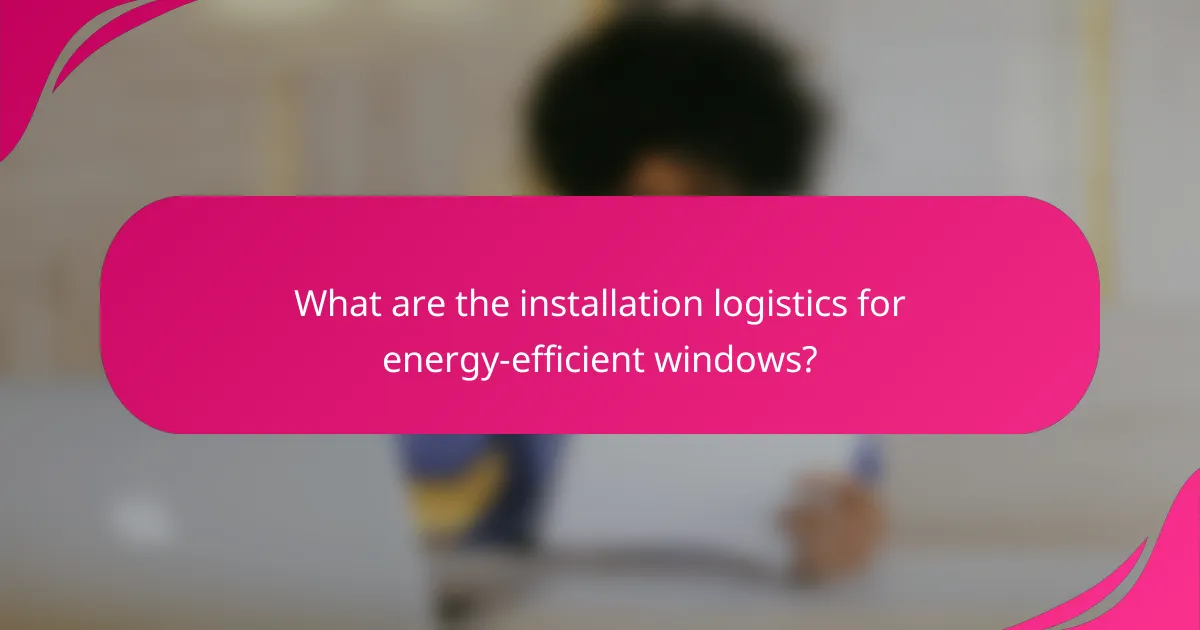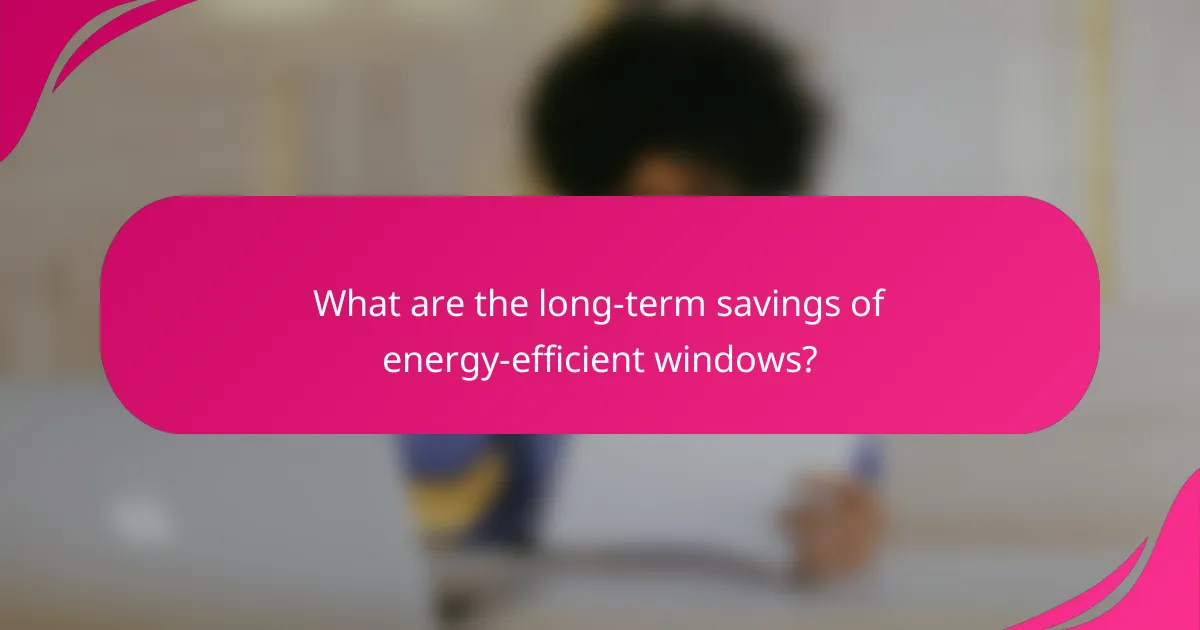Energy-efficient windows offer homeowners a sustainable choice that can lead to significant long-term savings. The pricing of these windows is determined by various factors, including material type, size, and installation complexity, which can vary widely based on location. Proper installation is crucial for maximizing their benefits, requiring careful planning and adherence to local regulations.

What are the pricing factors for energy-efficient windows?
The pricing of energy-efficient windows is influenced by several key factors, including material type, size, energy rating, installation complexity, and brand reputation. Understanding these elements can help homeowners make informed decisions that align with their budget and energy-saving goals.
Material type
The material of the window frame significantly affects the overall cost. Common materials include vinyl, wood, aluminum, and fiberglass, each with varying price points. For example, vinyl is often the most affordable option, while wood frames can be more expensive due to their aesthetic appeal and insulation properties.
Additionally, the durability and maintenance requirements of each material can influence long-term costs. Vinyl requires less upkeep than wood, which may need regular painting or sealing, impacting overall value over time.
Window size
Larger windows typically cost more than smaller ones, both in terms of materials and installation. Custom sizes or shapes can further increase costs, as they may require specialized manufacturing and fitting. Standard sizes are generally more affordable and easier to install.
When considering window size, it’s essential to balance aesthetics and energy efficiency. Larger windows can enhance natural light but may require more energy-efficient glazing to maintain thermal performance.
Energy rating
The energy rating of windows, often indicated by the National Fenestration Rating Council (NFRC) label, directly impacts pricing. Higher-rated windows, which offer better insulation and reduced energy costs, tend to be more expensive upfront. However, they can lead to significant savings on energy bills over time.
Investing in windows with a high energy rating can be beneficial in regions with extreme temperatures, as they help maintain indoor comfort and reduce heating and cooling expenses.
Installation complexity
The complexity of the installation process can greatly affect overall costs. If the installation requires extensive modifications to the existing structure or if the windows are particularly large or heavy, labor costs will increase. Simple replacements of existing windows are generally less expensive.
Homeowners should consider hiring experienced professionals for installation to ensure proper sealing and insulation, which can enhance the windows’ energy efficiency and longevity.
Brand reputation
The reputation of the window brand can influence pricing, as well-known brands often charge a premium for their products. Established brands may offer better warranties and customer service, which can add value to the investment.
When choosing a brand, it’s advisable to research customer reviews and ratings to ensure that the investment aligns with quality expectations and long-term performance.

How much do energy-efficient windows cost in major US cities?
The cost of energy-efficient windows varies significantly across major US cities, influenced by factors such as local labor rates, window materials, and energy efficiency ratings. Generally, homeowners can expect to pay between $300 and $1,000 per window, including installation, depending on the city and specific requirements.
Cost in Los Angeles
In Los Angeles, the price for energy-efficient windows typically ranges from $400 to $800 per window. Factors such as the choice of frame materials—vinyl, wood, or aluminum—can impact the overall cost. Installation fees may also vary based on the complexity of the job and local labor rates.
Homeowners should consider the long-term savings on energy bills, which can offset the initial investment. Additionally, check for local rebates or incentives that may be available for energy-efficient upgrades.
Cost in New York City
Energy-efficient windows in New York City generally cost between $500 and $1,000 per window. The higher end of this range often reflects the need for specialized installation due to building codes and regulations in the city. The choice of double or triple glazing can also affect pricing.
Investing in these windows can lead to significant savings on heating and cooling costs, especially in a climate that experiences both hot summers and cold winters. Homeowners should explore financing options that may be available through local programs.
Cost in Chicago
In Chicago, homeowners can expect to pay approximately $350 to $900 per window for energy-efficient options. The price may vary based on the window’s energy rating and the materials used. Installation costs can be higher in older buildings that require additional modifications.
Considering the harsh winters, energy-efficient windows can provide substantial savings on heating bills. It’s advisable to obtain multiple quotes from contractors to ensure competitive pricing and quality installation.

What are the installation logistics for energy-efficient windows?
The installation logistics for energy-efficient windows involve careful planning and execution to ensure optimal performance and compliance with local regulations. Key considerations include preparation steps, the timeframe for installation, and any necessary permitting requirements.
Preparation steps
Before installation, assess the existing window frames and surrounding areas for any damage or necessary repairs. Clear the work area of furniture and obstructions to facilitate access for installers. It’s also advisable to measure the windows accurately and choose the right type of energy-efficient windows that fit your home’s style and energy-saving goals.
Gather all necessary materials, such as insulation, caulking, and flashing, to ensure a smooth installation process. Consulting with a professional can help identify any additional items needed based on your specific situation.
Timeframe for installation
The installation of energy-efficient windows typically takes one to two days, depending on the number of windows being replaced and the complexity of the job. For a standard home with several windows, expect the process to be completed within a day, while larger projects may require additional time.
Weather conditions can also impact the timeframe, as installations should ideally be done in dry conditions to ensure proper sealing and insulation. Plan accordingly to avoid delays due to inclement weather.
Permitting requirements
Permitting requirements for installing energy-efficient windows vary by location. Many municipalities do not require a permit for window replacements, but some may have specific regulations, especially if the windows are part of a larger renovation project.
Check with your local building department to determine if a permit is necessary. If required, ensure all necessary documentation is submitted before starting the installation to avoid potential fines or delays.

What are the long-term savings of energy-efficient windows?
Energy-efficient windows can lead to significant long-term savings by reducing heating and cooling costs, enhancing comfort, and increasing property value. Over time, the initial investment in these windows often pays off through lower energy bills and improved home resale potential.
Energy bill reductions
One of the primary benefits of energy-efficient windows is their ability to lower energy bills. By minimizing heat loss in winter and heat gain in summer, these windows can reduce heating and cooling costs by approximately 10-25%. Homeowners can expect to see a noticeable difference in their monthly utility expenses, especially in regions with extreme temperatures.
To maximize savings, consider windows with a high energy efficiency rating, such as those certified by ENERGY STAR. These windows often feature advanced glazing technologies and better insulation, which can further enhance energy savings.
Return on investment
The return on investment (ROI) for energy-efficient windows can be substantial. Homeowners typically recoup about 70-80% of their initial costs when selling their homes. This ROI varies based on factors like local real estate trends and the overall energy efficiency of the home.
When calculating ROI, consider not only the energy savings but also potential tax credits or rebates available for energy-efficient upgrades. Many regions offer financial incentives that can offset the initial costs, making the investment even more appealing.
Increased property value
Installing energy-efficient windows can enhance a property’s market value. Homes with these upgrades often attract more buyers, as energy efficiency is increasingly prioritized in the real estate market. Properties with lower energy costs and improved comfort levels are seen as more desirable.
In some cases, energy-efficient windows can set a home apart in a competitive market, leading to quicker sales and potentially higher offers. Investing in these windows not only benefits current homeowners but also appeals to future buyers looking for sustainable living options.

What are the benefits of different window materials?
Different window materials offer unique benefits that can significantly impact energy efficiency, durability, and aesthetics. Understanding these advantages helps homeowners make informed decisions when selecting windows for their properties.
Vinyl windows
Vinyl windows are known for their excellent insulation properties and low maintenance requirements. They are typically less expensive than wood or fiberglass options, making them a popular choice for budget-conscious homeowners.
These windows resist moisture, which prevents warping and rotting, and they come in various colors and styles. When considering vinyl, look for options with multi-chambered frames for better thermal performance.
Wood windows
Wood windows provide a classic aesthetic and superior insulation, making them a great choice for energy efficiency. However, they require regular maintenance, such as painting or sealing, to protect against the elements.
While wood windows can be more expensive upfront, they often add value to a home due to their appeal. When choosing wood, consider options treated for weather resistance to prolong their lifespan.
Fiberglass windows
Fiberglass windows combine the durability of vinyl with the aesthetic appeal of wood. They are resistant to warping and can be painted or stained to match any home design.
Though they tend to be pricier than both vinyl and wood, their long-term energy savings and low maintenance make them a worthwhile investment. Look for fiberglass windows with a high energy performance rating to maximize efficiency.

How do energy-efficient windows compare to standard windows?
Energy-efficient windows significantly outperform standard windows in terms of insulation and energy savings. They are designed to minimize heat loss in winter and reduce heat gain in summer, leading to lower energy bills and increased comfort.
Energy performance
Energy performance refers to how well windows insulate and reduce energy consumption. Energy-efficient windows typically feature multiple panes, low-emissivity (Low-E) coatings, and gas fills like argon or krypton, which enhance thermal performance. In contrast, standard windows often have single panes and minimal insulation, leading to higher energy costs.
When selecting windows, consider the U-factor and Solar Heat Gain Coefficient (SHGC) ratings. The U-factor measures heat transfer, while SHGC indicates how much solar radiation passes through. Energy-efficient windows usually have U-factors below 0.30 and SHGC ratings tailored to your climate, maximizing comfort and savings.
For example, in colder regions, windows with lower U-factors are preferable, while warmer climates benefit from lower SHGC ratings. Always check for ENERGY STAR certification, which ensures compliance with energy efficiency standards relevant to your area.
